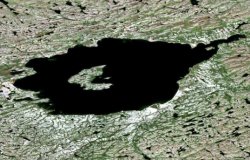November Editorial

November Editorial
The Hottest temperatures on Earth |
|
In the freezing mid-November temperatures of Labrador in Canada it is hard to imagine that roughly 36 million years ago temperatures reached 2370oC; or about the half the temperature of the sun. Geologists reckon this is the highest temperature ever reached on the surface of the Earth. It happened in Labrador's Mistastin crater (ref 1). |
|
|
The Mistastin crater was created by an asteroid impact which formed a depression approximately 28 km in diameter. Today, this is Mistastin lake, an elliptical, east–north-east trending depression approximately 11 km in diameter, cut into barren, moderately rugged hills of Pre-Cambrian rock. (Granitoid and anorthositic - a type of intrusive igneous rock composed predominantly of calcium-rich plagioclase feldspar). The crater was discovered in 1965 by geologists S. Duffell and F. C. Taylor who noticed volcanic rocks at the western end of the lake. Radiometric analysis of the rocks put them at about 202 million years old. The horseshoe island in the middle of the lake of Pre-Cambrian rocks led K.L. Currie, who was working for the Geological Survey of Canada, to conclude that what he was looking at was a newly-discovered crater. He published this observation in Nature in 1968 (ref 2). Today the crater is often used by space scientists as a stand-in or "analog" for the far side of the moon because both places are covered in anorthosite. In 2011 Michael Zanetti (now a post-doctoral researcher in Earth Sciences at Western University in London, Ontario) was part of the scientific group studying the area. In the process he came across a rather unusual-looking rock. This fist-sized, glassy rock was taken to the lab for further analysis. "When we looked at this, we saw that there was this kind of weird-looking zircon grain." said Zanetti. Furthermore, the zircon grain was surrounded by a strange brown rim. Zircon is one of the toughest known minerals. Zircons seem to survive most geologic processes, including erosion, transport, even high-grade metamorphism. It doesn't melt, even at temperatures that melt all the surrounding rocks. But while it does not melt, Zircon can be broken down into other minerals, namely zirconia (Zirconium dioxide (ZrO2) which is a white crystalline oxide of zirconium) and silica. For this to occur Zircon has to be superheated to temperatures in excess of 2370oC. Analysis of the brown rim surrounding the Zircon grains in Zanetti's rock revealed that it indeed was once a cubic zirconia. Therefore when the asteroid hit, the rock must have been exposed to a temperature of at least 2370oC, but not more than 2,650oC because at this temperature the Zirconia melts. What makes the present studies so much more interesting is that normally it is almost impossible to figure out the temperature at the time of an event tens of millions of years ago. This new temperature determination is the highest recorded for any rock in the earth’s crust and therefore provides evidence suggesting that the early cosmic bombardment of the Earth’s surface dramatically changed its geological makeup. Journal Reference: | |
| _______________________________ | ||||
| Home | | | Shopping | | | Database |
© Biscuit Software 2004-2017
All rights reserved